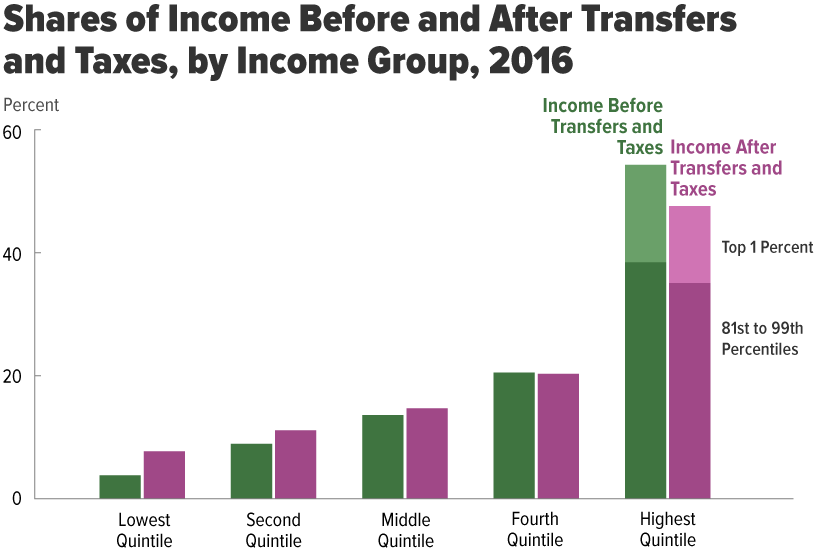Average Household Income Of The Top 1 Percent Was $1.8 Million Before Taxes And Transfers And $1.6 Million After: CBO Report
From CBO, "T
he Distribution of Household Income, 2016" July, 9, 2019, report:
What Was the Distribution of Income in 2016 Before Taxes and Transfer Payments?
First, CBO analyzed household income excluding the effects of federal taxes and means-tested transfers (which include benefits from Medicaid, the Supplemental Nutrition Assistance Program, and Supplemental Security Income). According to the agency’s estimates, in that year:
- Average income among households in the lowest quintile (or fifth) of the income distribution was about $21,000;
- Average income among households in the highest quintile—that is, the top 20 percent—was about $291,000; and
- Average income among households in the top 1 percent was about $1.8 million.
Those amounts include social insurance benefits (such as benefits from Social Security and Medicare).
How Did Means-Tested Transfers and Federal Taxes Affect the Distribution of Income in 2016?
Means-tested transfers and federal taxes are both progressive. That is, low-income households receive a larger share of their income as means-tested transfers than do high-income households, and high-income households pay a larger share of their income in federal taxes than do low-income households. Because of the progressive structure of those systems, the distribution of income after transfers and taxes is more even than the distribution of income before transfers and taxes. In 2016, according to CBO’s estimates, those transfers and taxes:
- Increased income among households in the lowest quintile by $14,000 (or more than 65 percent), on average, to $35,000,
- Decreased income among households in the highest quintile by $76,000 (or more than 25 percent), on average, to $215,000, and
- Decreased income among households in the top 1 percent by $600,000 (or more than 33 percent), on average, to $1.2 million.
Not all households receive means-tested transfers. In fact, those transfers went overwhelmingly to low-income households in 2016. Over 50 percent of means-tested transfers went to households in the lowest income quintile, which amounted to 72 percent of income before transfers and taxes for those households. Less than 4 percent of means-tested transfers went to households in the highest quintile, which amounted to less than one-half of one percent of income for those households. Households in all quintiles have some form of federal tax burden, but high-income households paid the majority of federal taxes in 2016. Households in the highest income quintile, which received about 54 percent of all income, paid about 69 percent of federal taxes. The average federal tax rate for those households was about 27 percent. Households in the lowest quintile, which received about 4 percent of all income, paid less than one-half of one percent of federal taxes. The average federal tax rate for those households was less than 2 percent. Households in the top 1 percent of the distribution received 16 percent of income and paid 25 percent of federal taxes; their average federal tax rate was about 33 percent.
What Are the Trends in Household Income and Income Inequality?
According to CBO’s estimates, average household income before transfers and taxes was almost 60 percent higher in 2016 than it was in 1979 in real (inflation-adjusted) terms—reflecting an average growth rate of 1.3 percent per year. That growth, however, was not the same across the income distribution. For the lowest quintile and the middle three quintiles, it was 33 percent (or 0.8 percent per year), but for the highest quintile, it was 99 percent (or 1.9 percent per year). For the top 1 percent of the income distribution, it was 218 percent (or 3.2 percent per year). Because of those differences in growth rates, income inequality was greater in 2016 than it was in 1979 [omitted interactive graphic]. For the lowest quintile, cumulative growth in income after transfers and taxes (85 percent, or 1.7 percent a year) was significantly greater over the period than was growth in income before transfers and taxes (33 percent). That change was due to an expansion of means-tested transfers (especially Medicaid benefits) and a reduction in federal taxes (largely from an expansion of refundable tax credits). By contrast, for the highest quintile, cumulative growth in income after and before transfers and taxes was similar, at 101 percent and 99 percent, respectively. The same was true for the top 1 percent of the income distribution: 226 percent versus 218 percent. Because of the redistributive nature of means-tested transfers and federal taxes, the degree of income inequality was less after transfers and taxes than it was before. Over the 1979–2016 period, the extent to which those policies reduced income inequality increased.

No comments:
Post a Comment